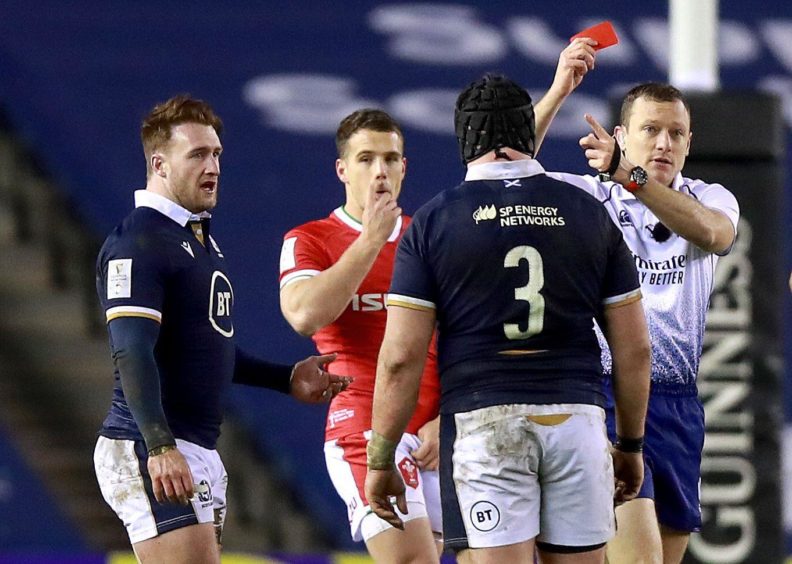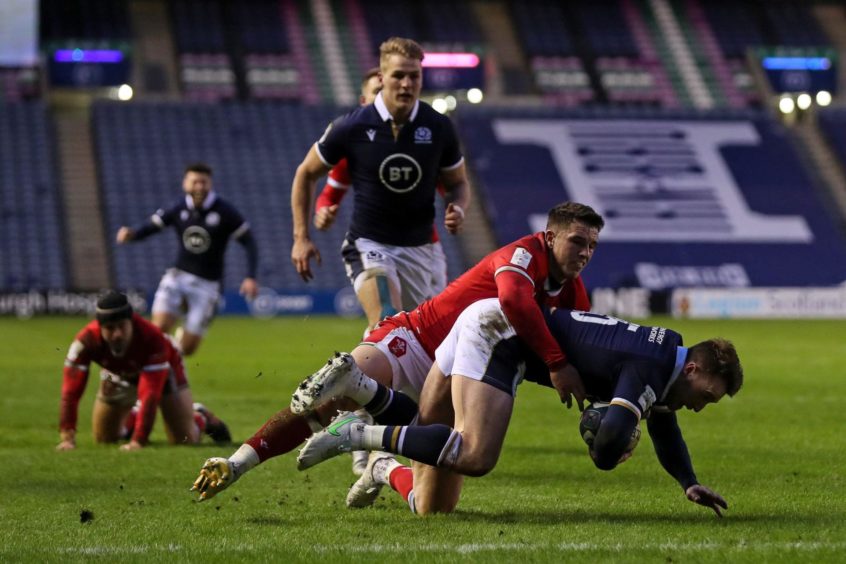Scotland were entirely the architects of their own spectacular downfall from the widespread euphoria of the England win to the crushing disappointment against Wales at Murrayfield on Saturday.
The subsequent attempt by some – even within the Scottish camp – to pin this on referee Matt Carley is an exceedingly ugly look.
Scotland have a history with Carley. The Englishman was roundly criticised for his handling of the epic match with the All Blacks in 2017. He gave 15 penalties against Scotland in Dublin in the final match of the Autumn Nations Cup just last November.
But to call into question his competency and interpretation serves absolutely no purpose.
Carley called it as he saw it. Taking a dispassionate view it’s hard to make many marginal cases that he got even a fraction of his 24 penalty calls (for both sides, the count finished 11-13 in Scotland’s favour) wrong.
It’s certainly hard to make any such case for his decision to red card Zander Fagerson, pinpointed as the matches’ turning point.
‘An absolutely dreadful call’
Gregor Townsend openly questioned the officiating team’s process immediately after the game. Hamish Watson called it “an absolutely dreadful call”.
The process was fine – the referee always has the final call. While there was maybe a tiny slice of mitigation, one struggled to see any difference at all between Fagerson’s dangerous clearout and that of Peter O’Mahony for Ireland against Wales last week.
Nobody questioned Wayne Barnes’ decision then, nor the three match ban O’Mahony got in midweek. Zander can expect at least the same sanction.
Now then, Zander Fagerson red card here I'd say.
Flying shoulder to the head… #SCOvWAL
— Cardiff Rugby Life (@CardiffRugbyWeb) February 13, 2021
It’s a dangerous game for the Scots to start singling out refs. Having got by far the better from Andrew Brace in their historic win at Twickenham (15-6 in their favour away from home!) they ought to keep their mouths shut.
In addition, another ref the Scots have publicly criticised in the past, France’s Romain Poite, has the whistle for the round 4 game against Ireland.
@ZanderFagerson Tough call today fellah. I thought it undeserved.
— David Lyn Jones 🏴 (@isthatasyrup) February 13, 2021
Let’s ignore conspiracy theories and admit that the Scots blew this one spectacularly. In the opening half-hour it seemed an almost unheard of instance – a game against the other original four nations which was going to be largely stress-free.
Pure poetry in the first 30 minutes
After a spate of penalties against them to start – a harbinger of things to come – the Scots played free, inventive and dominating rugby. When Finn Russell’s offload sent Jonny Gray galloping through tackles and set up Ali Price to deftly chip for Darcy Graham’s try, it was pure poetry.
Scotland even dusted off one of their favourite party pieces – the loop-and-long-pass move that produced Darcy’s second try in Twickenham in 2019. Again it worked: this time it was Stuart Hogg who burst into the line and kicked a grubber Leigh Halfpenny couldn’t deal with, the captain scoring after collecting the loose ball.
But they clearly hadn’t learned the other lesson of Twickenham 2019 – no lead is safe. At 17-3 Wales’ jugular was exposed, but the Scots didn’t go for it.
A spate of unnecessary penalties gave Wales a foothold
The errors started immediately on restart, a knock on before the exit from their own 22. They got away with that, but after Darcy Graham was taken out by Halfpenny – whose dire half-hour ended there with a head knock – the Scots had a lineout deep in the 22.
But Gary Graham gave away a silly sealing off penalty, Scotland’s first offence since three in the first four minutes had produced the early Halfpenny penalty. Wales kicked clear, two Scots infringed around the maul. The Welsh kicked the line again, then Graham high-tackled Taulupe Faletau.
Dan Biggar kicked the line again, Wales drove the lineout well and had another penalty advantage if they needed it. But they worked it outside Scotland’s defence for Louis Rees-Zammit’s first score.
Four minutes, four offences, three penalties and a situation where Scotland could reasonably have been looking at 24-3 to scrambling to half-time at 17-8. What should have been a comfortable victory was lost right there. Wales had to do little but run a couple of well-drilled lineouts and mauls.
Graham was the victim at Scotland’s next blunder. Scott Cummings clumsily got in his the way early in the second half for what should have been a routine try and 24-8. Instead Wales bounced straight up the field and scored through Liam Williams. That set the scene at 17-15 for the Fagerson Files.
Wales made full use of the extra man
After that, with 26 minutes left, Scotland had lost composure and were already chasing the game. Credit to Wales, with Scotland now the ones exposed, Wayne Pivac chanced everything. He took off the stolid Dan Biggar and set his team to make full use of the extra man.
Scotland actually did well to lead through Hogg’s second try going into the last ten minutes. Rees-Zammit’s brilliant solo score won it, but Darcy Graham actually comfortably outplayed the Welsh wonderkid when they were both on the pitch. The livewire Scot was lost to the reshuffle after the red card.
We thought Scotland’s belief and composure under pressure after Twickenham were rock-solid; instead the few examples scattered around that victory were magnified when things turned against them.
The fault that was disguised at Twickenham
There are things that can be solved. The dreadful lineout maul defence – another thing we thought had been cured – the marginal offsides, the unnecessary infringements.
But it comes to back to the disguised fault at Twickenham – taking scoring chances. If Scotland won’t kick easy penalties they simply must score when they have these opportunities.
The teams Scotland aspire to match – France, Ireland, Wales and yes, England – would all score in that situation after half-time. The Scots need to find a way to be the same.





